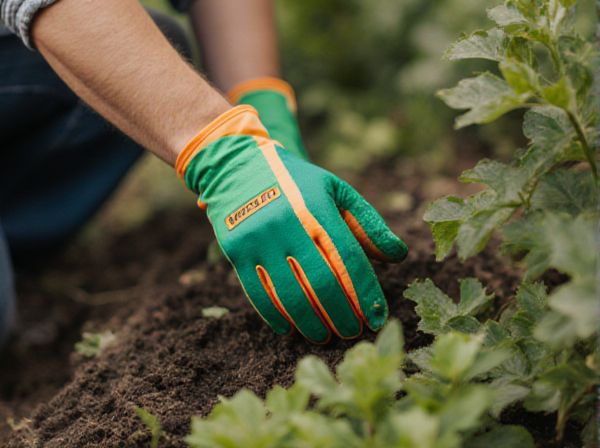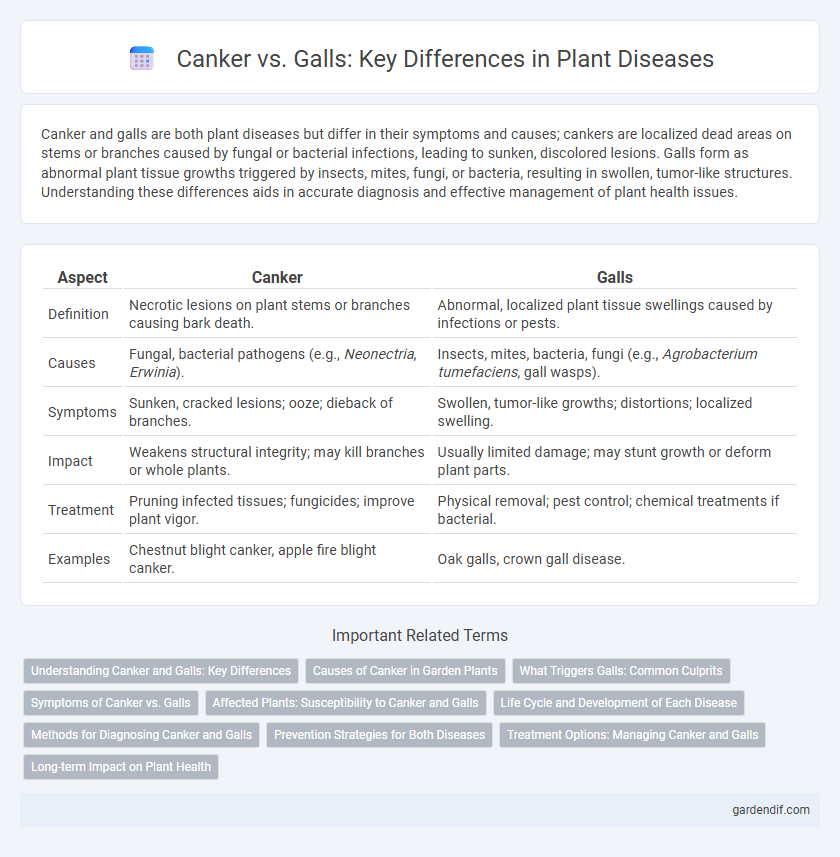
Canker vs Galls Illustration
Canker and galls are both plant diseases but differ in their symptoms and causes; cankers are localized dead areas on stems or branches caused by fungal or bacterial infections, leading to sunken, discolored lesions. Galls form as abnormal plant tissue growths triggered by insects, mites, fungi, or bacteria, resulting in swollen, tumor-like structures. Understanding these differences aids in accurate diagnosis and effective management of plant health issues.
Table of Comparison
| Aspect | Canker | Galls |
|---|---|---|
| Definition | Necrotic lesions on plant stems or branches causing bark death. | Abnormal, localized plant tissue swellings caused by infections or pests. |
| Causes | Fungal, bacterial pathogens (e.g., Neonectria, Erwinia). | Insects, mites, bacteria, fungi (e.g., Agrobacterium tumefaciens, gall wasps). |
| Symptoms | Sunken, cracked lesions; ooze; dieback of branches. | Swollen, tumor-like growths; distortions; localized swelling. |
| Impact | Weakens structural integrity; may kill branches or whole plants. | Usually limited damage; may stunt growth or deform plant parts. |
| Treatment | Pruning infected tissues; fungicides; improve plant vigor. | Physical removal; pest control; chemical treatments if bacterial. |
| Examples | Chestnut blight canker, apple fire blight canker. | Oak galls, crown gall disease. |
Understanding Canker and Galls: Key Differences
Cankers are localized areas of dead bark on trees caused by fungal or bacterial infections, leading to sunken, cracked lesions that disrupt nutrient flow. Galls, by contrast, are abnormal plant growths induced by insects, mites, fungi, or bacteria, appearing as swollen, tumor-like structures on leaves, stems, or roots. Differentiating cankers from galls is crucial for accurate diagnosis and treatment, as cankers indicate tissue death while galls reflect abnormal cell proliferation.
Causes of Canker in Garden Plants
Canker in garden plants is primarily caused by fungal pathogens such as Botryosphaeria, Nectria, and Cytospora species, which infect through wounds or natural openings. Environmental stress factors like drought, frost damage, and poor nutrition increase susceptibility to canker infections. In contrast, galls are typically caused by insects, mites, bacteria, or fungi inducing abnormal plant tissue growth.
What Triggers Galls: Common Culprits
Galls are abnormal plant growths triggered by various organisms such as insects, mites, fungi, bacteria, and nematodes. Insects like gall wasps and aphids often lay eggs inside plant tissues, causing the plant to produce these distinctive swellings. Bacterial infections, notably Agrobacterium tumefaciens, also induce crown gall disease by inserting genetic material that disrupts normal cell growth.
Symptoms of Canker vs. Galls
Canker symptoms include sunken, discolored lesions on stems or branches, often oozing sap or resin, and can lead to dieback or girdling of the affected area. Galls appear as abnormal, rounded swellings or growths on leaves, stems, or roots caused by insect, mite, or pathogen activity, disrupting normal tissue development. While cankers typically indicate fungal or bacterial infection damaging vascular tissues, galls represent localized tissue proliferation without widespread tissue death.
Affected Plants: Susceptibility to Canker and Galls
Canker primarily affects trees such as oaks, maples, and fruit trees like apples and cherries, causing sunken lesions on bark that can lead to branch dieback. Galls commonly form on a wide range of plants including oaks, roses, and various shrubs, inducing abnormal growths caused by insects, mites, or fungi. Susceptibility varies with species and environmental conditions, where stressed or weakened plants show increased vulnerability to both canker infections and gall infestations.
Life Cycle and Development of Each Disease
Canker diseases develop through fungal or bacterial pathogens that invade plant tissues via wounds, leading to sunken lesions as the pathogens colonize and kill bark cells, with spores dispersing primarily during wet conditions to infect new hosts. Gall diseases form when insects, mites, or bacteria stimulate abnormal plant cell growth, creating localized swollen structures that provide a habitat and nutrition for the gall-inducing organism, with their lifecycle often synchronized to the host plant's growth stages. The development of cankers often results in progressive tissue death and bark cracking, whereas galls persist as discrete tumor-like growths that may distort plant morphology but rarely cause extensive tissue necrosis.
Methods for Diagnosing Canker and Galls
Canker diagnosis primarily involves visual inspection of sunken, dead areas on stems or branches, accompanied by laboratory tests such as fungal culture or PCR to identify pathogens like Cryptosporella or Nectria species. Gall diagnosis requires detection of abnormal, localized swellings caused by insects, mites, or bacterial infections, confirmed through microscopic examination and pathogen isolation. Accurate differentiation relies on symptom assessment combined with molecular techniques to ensure targeted disease management.
Prevention Strategies for Both Diseases
Implementing proper sanitation by removing infected plant material significantly reduces the spread of both canker and galls. Applying appropriate fungicides and bactericides tailored to the specific causative agents helps in early disease control. Maintaining plant vigor through balanced fertilization and adequate watering enhances resistance against these diseases.
Treatment Options: Managing Canker and Galls
Treatment options for managing canker include pruning infected branches during dry weather to prevent fungal spread and applying fungicides containing copper or sulfur to protect healthy tissue. Galls can be managed by removing and destroying affected plant parts, encouraging natural predators like parasitic wasps, and using systemic insecticides if the gall-inducing pests are identified. Implementing proper cultural practices such as maintaining plant health, ensuring good air circulation, and avoiding mechanical injury significantly reduces the incidence of both canker and galls.
Long-term Impact on Plant Health
Canker causes localized tissue death, leading to weakened structural integrity and increased vulnerability to secondary infections, which can severely reduce a plant's lifespan. Galls result from abnormal tissue growth that diverts nutrients, often causing stunted growth and diminished reproductive capacity over time. Both conditions compromise plant health but differ in their mechanisms of damage and long-term physiological effects.
Canker vs Galls Infographic

 gardendif.com
gardendif.com